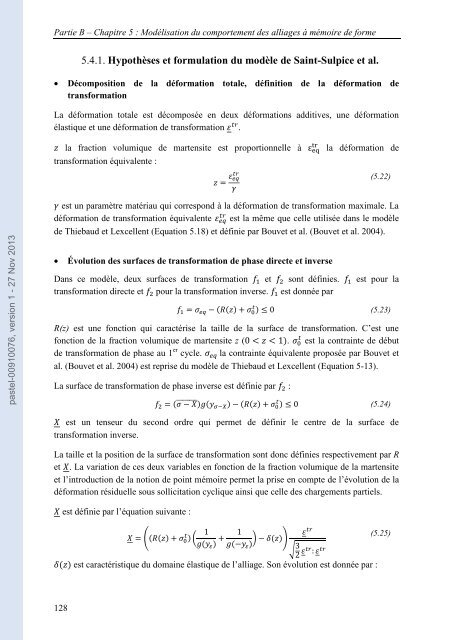Dialogue essais-simulation et identification de lois de comportement ...
Dialogue essais-simulation et identification de lois de comportement ...
Dialogue essais-simulation et identification de lois de comportement ...
You also want an ePaper? Increase the reach of your titles
YUMPU automatically turns print PDFs into web optimized ePapers that Google loves.
Partie B – Chapitre 5 : Modélisation du <strong>comportement</strong> <strong>de</strong>s alliages à mémoire <strong>de</strong> forme<br />
5.4.1. Hypothèses <strong>et</strong> formulation du modèle <strong>de</strong> Saint-Sulpice <strong>et</strong> al.<br />
<br />
Décomposition <strong>de</strong> la déformation totale, définition <strong>de</strong> la déformation <strong>de</strong><br />
transformation<br />
La déformation totale est décomposée en <strong>de</strong>ux déformations additives, une déformation<br />
élastique <strong>et</strong> une déformation <strong>de</strong> transformation .<br />
la fraction volumique <strong>de</strong> martensite est proportionnelle à<br />
transformation équivalente :<br />
la déformation <strong>de</strong><br />
(5.22)<br />
pastel-00910076, version 1 - 27 Nov 2013<br />
est un paramètre matériau qui correspond à la déformation <strong>de</strong> transformation maximale. La<br />
déformation <strong>de</strong> transformation équivalente est la même que celle utilisée dans le modèle<br />
<strong>de</strong> Thiebaud <strong>et</strong> Lexcellent (Equation 5.18) <strong>et</strong> définie par Bouv<strong>et</strong> <strong>et</strong> al. (Bouv<strong>et</strong> <strong>et</strong> al. 2004).<br />
<br />
Évolution <strong>de</strong>s surfaces <strong>de</strong> transformation <strong>de</strong> phase directe <strong>et</strong> inverse<br />
Dans ce modèle, <strong>de</strong>ux surfaces <strong>de</strong> transformation <strong>et</strong> sont définies. est pour la<br />
transformation directe <strong>et</strong> pour la transformation inverse. est donnée par<br />
(5.23)<br />
R(z) est une fonction qui caractérise la taille <strong>de</strong> la surface <strong>de</strong> transformation. C’est une<br />
fonction <strong>de</strong> la fraction volumique <strong>de</strong> martensite z ( . est la contrainte <strong>de</strong> début<br />
<strong>de</strong> transformation <strong>de</strong> phase au 1 er cycle. la contrainte équivalente proposée par Bouv<strong>et</strong> <strong>et</strong><br />
al. (Bouv<strong>et</strong> <strong>et</strong> al. 2004) est reprise du modèle <strong>de</strong> Thiebaud <strong>et</strong> Lexcellent (Equation 5-13).<br />
La surface <strong>de</strong> transformation <strong>de</strong> phase inverse est définie par :<br />
(5.24)<br />
est un tenseur du second ordre qui perm<strong>et</strong> <strong>de</strong> définir le centre <strong>de</strong> la surface <strong>de</strong><br />
transformation inverse.<br />
La taille <strong>et</strong> la position <strong>de</strong> la surface <strong>de</strong> transformation sont donc définies respectivement par R<br />
<strong>et</strong> . La variation <strong>de</strong> ces <strong>de</strong>ux variables en fonction <strong>de</strong> la fraction volumique <strong>de</strong> la martensite<br />
<strong>et</strong> l’introduction <strong>de</strong> la notion <strong>de</strong> point mémoire perm<strong>et</strong> la prise en compte <strong>de</strong> l’évolution <strong>de</strong> la<br />
déformation résiduelle sous sollicitation cyclique ainsi que celle <strong>de</strong>s chargements partiels.<br />
est définie par l’équation suivante :<br />
(5.25)<br />
est caractéristique du domaine élastique <strong>de</strong> l’alliage. Son évolution est donnée par :<br />
128
















